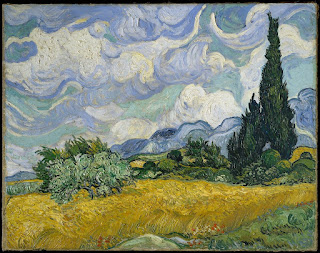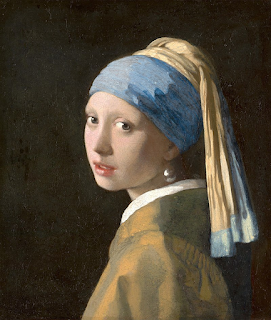Art Analysis of van Gogh’s Wheat Field with Cypresses by Abigail Williamson
Vincent van Gogh was a Dutch
impressionist painter in the 1800s. Although his work did not gain much
notoriety until after his death, his art is now recognized as some of the best
of its time. One of his more than 900 paintings is called Wheat Field
with Cypresses (Shinn-Morris). After living for two years in Paris,
developing his use of color and style, van Gogh began to grow tired of city
life and set off for the countryside (Vincent's).
In June of 1889, van Gogh began his first series of paintings in
Saint-Rémy focused on the area's distinctive cypress trees (Wheat). Wheat
Field with Cypresses in a 28 7/8 × 36 3/4 in. oil painting on canvas
is the first work that he made of nature with this composition
(Wheat). The work, such as this, that van Gogh made while living in the
south of Frances countryside symbolizes the end of an era in his work as it was
after this year that his mental health took a sharp decline which led to his
hospitalization (Vincent's).
I can understand van Gogh’s desire
to get away from the city to explore new places as I have only lived in places
for three years at a time and once that time begins to approach, I start to
feel the itch to leave for somewhere new. I would love to own a copy of this
painting or ever try recreating it at some point to try to understand van
Gogh’s creative prosses. More of van Gogh’s paintings should be displayed in
public places because I believe their swirling patterns and soft colors create
a dream-like sense of wonder that people from all walks of life can
enjoy.
There are many elements that
contribute to my enjoyment of this painting. First, the composition is
very pleasing in the way that the shape of the mountains leads the viewer's eye
to the largest cypress tree which then brings the eye to the clouds whose
swirling motion brings your eye back down to the mountains and wheat field which
guide you back to the cypresses. This
composition creates a great circular line of motion that helps contribute to
the enjoyment of the painting. Van Gogh developed a very distinctive style
over his career that included his use of small brush strokes. This is evident
in the painting and creates a beautiful texture that gives the work some natural
depth. This texture also contributes to the flowy, swirling pattern evident
throughout the image that gives the work a sense of unity. Another aspect I
enjoy is van Gogh’s use of color in this painting. The warm yellow of the wheat
fields and highlights on the trees create an element of contrast combined with
the cool blues that dominate the rest of the painting. although the painting
does contain contrasting warm ad cool colors their tones are kept at very
similar levels which creates cohesiveness throughout the image. Finally, by
having light blue dominate most of this painting's space van Gogh creates a
sense of peace and calm. Emotions of sadness are kept away from this very
cool piece by yellow being the other color in the work that occupies the most
space bringing feelings of joy to the picture and keeping away thoughts of
melancholy.
Regarding flaws or elements of this
painting that I don’t enjoy there are very few aspects that I don’t find
pleasing. I would like it if there was another, much smaller cypress on the far
left of the painting as I feel that the image is a bit right-heavy
composition-wise. Additionally, if the smaller cypress tree that is in the
image were slightly lighter in color, I feel that that would help to have them
read as two trees rather than one big one with a small gap at the base. The
last thing that I might critique is that I would love to see more of the yellow
in the sky, which seems to represent sunlight, carried threw the sky to help
carry the yellow throughout the painting and make it seem more deliberate.
Work Cited
Shinn-Morris, Leonie “10 Things You Might Not Know About
Van Gogh,” Google Arts and Culture, https://artsandculture.google.com/story/10-things-you-might-not-know-about-vincent-van-gogh/agLStrYjblBRKA.
Accessed 3, February 2023.
“Wheat Field with Cypresses,” The
MET, https://www.metmuseum.org/art/collection/search/436535.
Accessed 3, February 2023.
“Vincent's Life,” Van Gough Museum,
https://www.vangoghmuseum.nl/en/art-and-stories/vincents-life-1853-1890.
Accessed 3, February 2023.




This comment has been removed by the author.
ReplyDelete
ReplyDeleteThe painting that Van Gogh created is absolutely beautiful! I had no idea that he crafted more than 900 original paintings! That is such an impressive fact. I agree with you that the colors carry all sorts of different emotions. I also felt the sense of joy, peace, and calmness that you discussed. I think this is largely due to the fact that a majority of the colors were more muted, so those stronger emotions like sadness didn’t pull through as much.
I like that you touched on the element of texture present in the piece because I also researched a painting that incorporated a great deal of distinctive texture work. This type of prominent brushwork was very common with Fauvist artists in their landscape paintings starting in the twentieth century. If you want to learn a little more about the Fauvism artistic style, you should take a look through this website! Website: https://smarthistory.org/a-beginners-guide-to-fauvism/
Great discussion and great choice of art!!
Hi Abby! I learned so much about the painting that Van Gogh created! Is this an art piece you would try to create on your own and keep in your room or such? Van Gogh's art is very unique and pretty! When I see this artwork, I feel different types of emotions, as you mentioned in your post. I like arts that can give me emotions to it and feel attached to them. Great choice and explaining different types of art that were within Van Gogh's artwork! Great blog post!
ReplyDeleteThis comment has been removed by the author.
ReplyDeleteHello Abby, I love how in depth your analysis is and agreed with you on the points you have made. I found this piece to be very calming which I believe comes from the use of cool tones throughout the piece. I also appreciate the fact that you mentioned Gogh's brush strokes because I believe, especially in this piece, his brush strokes are very beautiful and have this majestic flow to them - especially the ones that make up the clouds.
ReplyDelete